Invisible Cities by Italo Calvino Review and Booknotes
Introduction
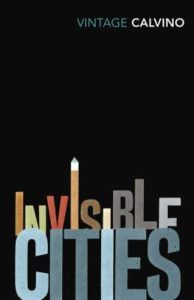
The Book Invisible Cities by Italo Calvino is a classic modernist novel yet has had a widespread popularity that elevates it above most books of its type and has come to have an enduring influence among artists and architects.
It’s a staple for architecture students and architects alike, but why is it so popular and what’s so interesting about it? After all it may not seem on first sight to be particularly relevant to the practice of architecture as although it proports to be about cities it’s actually a magical realist book whose cities are dreamlike creations. A post modern novel with little plot and seemingly a much more poetic dreamlike quality.
But on starting to read and being drawn into the novel I think it becomes apparent why this has become such a touchstone for creative thinking about design and cities and why many architects love it so much, me included.
Before the review I will give some background and have a more detailed look at the structure of the book. This I feel is really important because of the way the book was written. The structure of the book in fact, is an integral part of the beauty of its beauty.
The Author
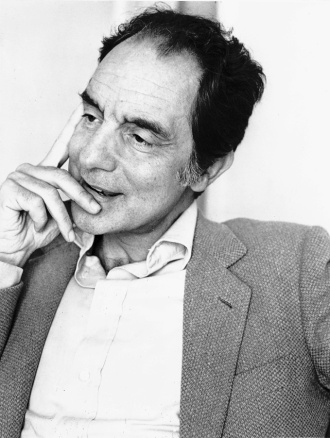
(from wikipedia page)
Italo Calvino born in Cuba but his Italian parents moved back with him when he was 2 years old. He went into hiding rather than join the fascist military of Benito Mussolini and later joined the underground resistance in WWII. After the war he graduated and became a much published and translated journalist and author. He is well known for playing with the narrative structure of his books and was associated with varies intellectual groups like the Structuralists and Oulipo that used maths as constraints to provoke and create meaning.
Italo Calvino gave a lecture to the students of the Graduate writing division at Columbia University on March 29, 1983 in which he talked about the writing of Invisible Cities.
He wrote the cities over a great deal of time, the cities were written like individual poems often reflecting the mood he was in then.
All these cities did not make a book by themselves. It needed a beginning and end and although not with a traditional plot;
It is a space which the reader must enter, wander round, maybe loose his way in, and then eventually find an exit, or perhaps even several exits, or maybe a way of breaking out on his own.
Calvino definitely tries to address the modern city today, introducing the mega cities of the present today also at the end of the book. Invisible Cities is poem to the city as Calvino sees it, more natural and reflective of nature and psychology rather than finance and technology. A natural place, home of the human mind.
A book…is a space in which a reader can enter, turn about, perhaps lose himself, but at a certain point find an exit…Some of you may tell me that this definition better suits a novel of plot, and not a book like this…All right, but I would claim that also a work like this, in order to be a book, must have a certain construction, in which it’s possible to discover a plot, an itinerary, a resolution. -Italo Calvino (talking about Invisible Cities ’83 Columbis Uni) Ref
Basic Structure
Invisible Cities presents itself as a conversation between Kublai Khan ruler of China and Marco Polo the 13th C explorer. For Invisible Cities this is the historical seed from which the book grows.
Marco Polo was born in 1254 (perhaps) in Venice he came from a wealthy Venetian based trading family. He travelled the Silk Road and ended up in the Yuan Dynasty of China that Kublai Khan founded. He stayed for some time and worked as a foreign emissary for Khan for 17 years before returning back to Venice.
Kublai Khan the grandson of Ghengis Khan, was the first non Han ruler Emperor of China and founder of the Yuan Dynasty.
The basic conceit of the book of a conversation between Khan and Polo is a lovely way for the book to explore its preoccupations. A meeting between East and West, the first on many opposites or reversals in the book.
This encounter had also become a jumping off point for other works of art. Samuel Taylor Coleridges’ poem Kubla Khan or A Vision in a Dream, one of the most famous poems in the English language has the subject of Kublai Khans’ Xanadu. So it was already a well used literary conceit by the time Calvino took it up. Again a kind of inflection point between ‘reality’ and art.
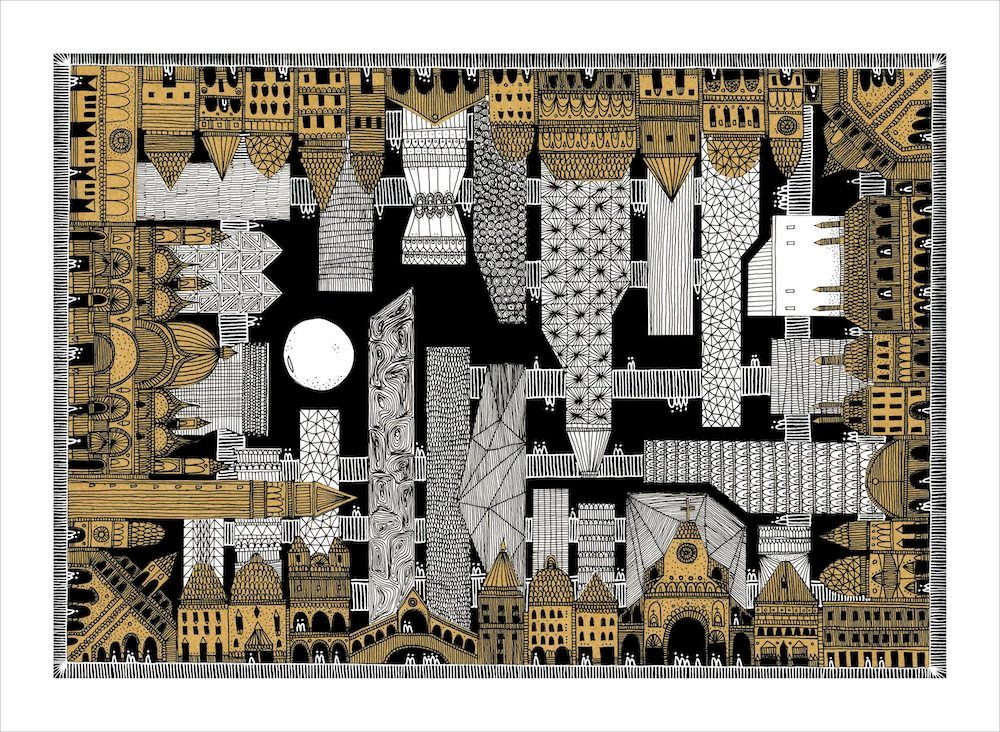
City of Maurilia by Karina Puente
City Structure
Only in Marco Polo’s accounts was Kublai Khan able to discern, through the walls and towers destined to crumble, the tracery of a pattern so subtle it could escape the termites’ gnawing.
Khan wants Polo to describe the cities he has visited on his travels. Polo describes 55 cities in 9 chapters. Calvino however has set out these cities in a really interesting way. The structure of the book is part of its beauty and worth describing.
The first and last chapter contain 10 cities and the other chapters contain 5 cities each. Each city carries a female name.
Moreover these invisible cities have a precise mathematical structure;
The cities fall into eleven categories, and each category features five model cities; thus there are fifty-five cities in all. The second through eighth chapters each have five cities that appear in a pattern whereby no two categories are repeated, one category is removed, and one new one is added. The cities are split into 11 themes;
1 Cities & Memory
2 Cities & Desire
3 Cities & Signs
4 Thin Cities
5 Trading Cities
6 Cities & Eyes
7 Cities & Names
8 Cities & the Dead
9 Cities & the Sky
10 Continuous Cities
11 Hidden CitiesHe moves back and forth between the groups, while moving down the list, in a rigorous mathematical structure.
This can be displayed graphically Line number is Chapter and entry is each cities theme as below :
- mem, mem, des, mem, des, sig, mem, des, sig, thi
- mem, des, sig, thi, tra
- des, sig, thi, tra, eye
- sig, thi, tra, eye, nam
- thi, tra, eye, nam, dea
- tra, eye, nam, dea, sky
- eye, nam, dea, sky, con
- nam, dea, sky, con, hid
- dea, sky, con, hid, sky, con, hid, con, hid, hid
The Maths
As you can see, the first and ninth chapters are twice as long (ten cities each), and do not follow the rules of the intermediate chapters. To set his pattern in motion (and wind it down at the end), Calvino had to create first and final chapters that work as bookends, and which by necessity had to repeat cities of the earliest and last categories.
The first chapter cities represented by number are;
1
1,2
1,2,3
1,2,3,4
The final chapter winds down the pattern;
8,9,10,11
9,10,11
10,11
11
(via)
Also you can order the opening and ending chapters in a helix so they continue forever, an infinite rotated sequence.
Fibonacci’s Sequence
The first and the final chapter bring to mind the Fibonacci sequence. Fibonacci was a 13th century Italian mathematician who died around the same time (1250) as Marco Polo was born (1254). The Fibonacci sequence is a series of numbers of which each number is the sum of the two numbers that preceded it. Thus;
0 , 1 , 1 , 2 , 3 , 5 , 8 , 13 , 21 , 34 , 55 , etc . . .
Like the structure of Invisible Cities, the Fibonacci sequence continues infinitely. It begins with a repetition of the number one, and Invisible Cities begins with a repetition of ‘Cities and desire’.
The Fibonacci series also has an interesting characteristic of particular relevance to the arts and architecture. If you take any number on the series and divide it by the number that precedes it you will get something close to the golden ratio approximately (1.618). As you go further through the series the number gets closer and closer to the golden ratio, oscillating above and below it ever closer.
Source for this argument (via)
The Golden Ratio and Golden Rectangle
The golden ratio is a number that’s found in nature wherever you look. You can find it in coil of a shell or the ratio of sizes of the human skeleton.

From the golden ratio you can generate the golden rectangle and architects have throughout the ages used it to compose their designs from Palladio to Le Corbusier across time and culture the golden ration has been incorporated in art and architecture. Even artists who create their works unaware of the golden ratio or golden rectangle will often find their artwork contains it such is its power to appear as a naturally good proportion.
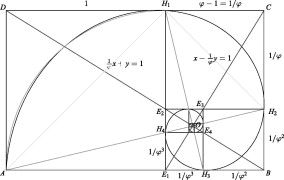
Why golden rectangle is used so often by architects: A mathematical approach - ScienceDirect
It seems entirely appropriate that Calvino who has created a structure of words should build this proportion into his book.
Connections
So the Calvino has rigorously structured the cities and subjects but the cities are also broken up by conversations between Polo and Khan.
These conversations are for me at least the parts of the book where Calvino can explain himself, where he gives meaning and direction to the overall structure of the book and the semi-poetic nature of the cities even as there is no traditional plot really. There is much to find here, like the rest of the book it’s often though now always somewhat obtuse in its meaning.
Khan wants Polo to describe the cities he has seen on his travels and Polo talks of them. Khan recognises these cities might not be true before being told by Polo they might be universal.
Not Historical Fiction, it is immediately apparent its more Magical Realism. Marco Polo is the explorer who ‘found’ the East. The meeting of East and West or Mystisism and Materiality.
The Cities
The cities themselves are like poems, they are frequently a little inscrutable and the text is dense. I often had to read a paragraph or so and then put it down and think thorough what I had just read. The cities general outlines are specific but no details or inhabitants are really clearly described.
There is a lot of this kind of shifting of the ideas of symbolic to realised and back again which really forces you to think for example with space and memory;
The city does not consist of this, but of relationships between the measurements of its space and the events of its past: the height of a lamppost and the distance from the ground of a hanged usurper’s swaying feet - Cities and Memory 3
There are constant reversals in the cities and the text itself. At one point Khan desires to instead describe cities to Polo and ask whether they exist, for example.
“From now on, I’ll describe the cities to you,” the Khan had said, “in your journeys you will see if they exist.” But the cities visited by Marco Polo were always different from those thought of by the emperor.
Or where Kahn feels that as Polo learns his language his descriptions of the cities begin to diminish in his eyes.
As with the Khan/Polo passage about the rules of chess this book also seems to be that just when you think you have learned the rules of the game they then shift. The metaphor of one thing being played out by something unseen but more fundamental plays out again also.
Venice
The City of Venice also takes center stage within these pages. It’s Polos home city and again it’s the city that bridges East and West architecturally and Earth and Sea conceptually. Calvino introduces the city in a series of reversals.
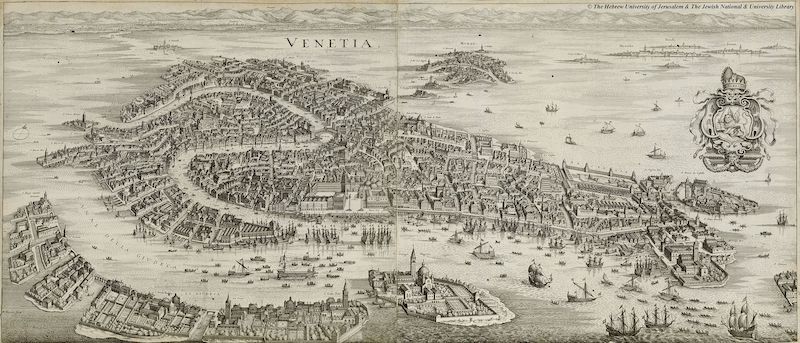
Khan asks if Polo has ever seen a city like this one with
The bridges arcing over the canals, the princely palaces whose marble doorsteps were immersed in the water, the bustle of light craft zig-zagging, driven by long oars….
It sounds exactly like Polos home city Venice but he denies this….
“No, sire,” Marco answered, “I should never have imagined a city like this could exist.”
However Khan knows this is a lie;
The emperor tried to peer into his eyes. The foreigner lowered his gaze. Kublai remained silent the whole day.
Polo then admits there is still one city he has not told Khan about, and Khan says Venice, he knows the city Polo is from and has been so shy about. Polo then admits;
Every time I describe a city I am saying something about Venice.
The next city is Trading Cities 5 Esmerelda. It sounds exactly like Venice, and then the next one again is Venice Cities and Eyes 4 Phyllis.
WHEN YOU HAVE arrived at Phyllis, you rejoice in observing all the bridges over the canals, each different from the others: cambered, covered, on pillars, on barges, suspended, with tracery balustrades.
Venice thus is the first and mainly only recognisable city here although real names are mentioned later it feels like the claim the Venice is in all cities and that all these cities describe some aspect of any city are true.
This — some say — confirms the hypothesis that each man bears in his mind a city made only of differences, a city without figures and without form, and the individual cities fill it up.
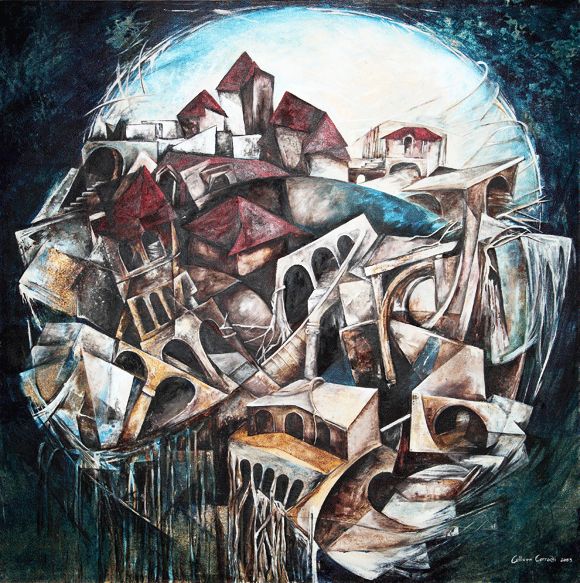
Fedora by Colleen Corradi Brannigan
Other Themes in Invisible Cities
So we have looked at the mathematical structure of the book manifested in how the cities are arranged, and how the cities are connected in a conversation between Polo and Khan which leads through a more recognisable structure of a novel with the two principal characters relationship changing through the book.
Also I have touched on the Cities themselves the play the book makes around the city of Venice but what else of the themes and impressions of the book?
The Arch
One relevant design theme I love in this book we could call The Arch
There is one story in which;
Marco Polo describes a bridge, stone by stone. “But which is the stone that supports the bridge?” Kublai Khan asks. “The bridge is not supported by one stone or another,” Marco answers, “but by the line of the arch that they form.” Kublai Khan remains silent, reflecting. Then he adds: “Why do you speak to me of the stones? It is only the arch that matters to me.” Polo answers: “Without stones there is no arch.” - Italo Calvino (Invisible Cities)
I think this is a common thread running through the book found in almost every city. There is a visible sign of something invisible. These two things rely on each other. Thus the Arch is a kind of metaphor for the Invisible city. Calvino isn’t really talking about the physical city in the book but the invisible things about cities, about human lives and feelings brought into material reality by those things these cities manifest. Neither exists independent of each other. The cities are often written in this way;
The city, however, does not tell its past, but contains it like the lines of a hand, written in the corners of the streets, the gratings of the windows, the banisters of the steps, the antennae of the lightning rods, the poles of the flags, every segment marked in turn with scratches, indentations, scrolls.
As Metaphor / Dream
This is the most obvious reading of the book. The Cities are all Venice for Marco Polo, all one aspect of the city or maybe all cities. The descriptions of the cities are more memories refracted from that place of which they speak. It’s like a memories or dreams;
Cities, like dreams, are made of desires and fears, even if the thread of their discourse is secret, their rules are absurd, their perspectives deceitful, and everything conceals something else.
They only really exist in your mind, or more exactly like the arch the line of the arch holds up the stones, but without the stones there is no arch.
How does the materiality and experiential world touch maybe this is your Invisible City?
Invisible Cities is in some ways architecture without buildings.
Structuralism
The belief that phenomena of human life are not intelligible except through their interrelations. These relations constitute a structure, and behind local variations in the surface phenomena there are constant laws of abstract structure. - Simon Blackburn (via)
Again the metaphor of The Arch might inform the structuralist reading of the book that the metaphor or dream reading of the book is nonetheless a relevant, realistic reading. It informs us about real things through their links to the unseen, to the dreams and unconscious, unuttered nature of ourselves.
Poetics of the City
The descriptions of cities Marco Polo visited had this virtue: you could wander through them in thought, become lost, stop and enjoy the cool air, or run off.
Italo Calvino through Polo explains his cities well, the cities are like short poems. I think its from within these cities that the reader will fall in love with the book.
The last cities start sounding a little more real - we hear of real cities past and future mentioned, there is a pleas for good cities. Polo admits that his cities are talking about all cities perhaps for all time.
Conclusion
Apart from the themes already mentioned there are many more within the book. The cycle of death and rebirth, the power and limits of language, the perception of memory and of truth its all there to be discovered.
You are reading a piece of art, a reubus, a crystaline shard that reflects and refracts the stone blocks of a dream. It might not all make sense but it will mesmerise and cast its spell on you. Sometime through the dialogue of sometimes senseless imagery a lucid paragraph will cut to the truth of something that will stop you in your tracks.
I love this book and I think its worth everyone trying it, you might just love it too.
Elsewhere
It’s also worth mentioning that the book has acquired a life outside of its own pages so to speak. One of the most fantastic things about Invisible Cities is that it has inspired down the years so many different artists in different fields.
It inspires and directly contributes to new original art in a way that books mostly just don’t do.
Further Reading
- Interview with Italo Calvino here
- Study webpage litcharts
- For Artists inspired by Invisible Cities see karinapuente and Colleen Corradi Brannigan to name just two.
- Music Christopher Cerrone wrote an Opera inspired by Invisible Cities.